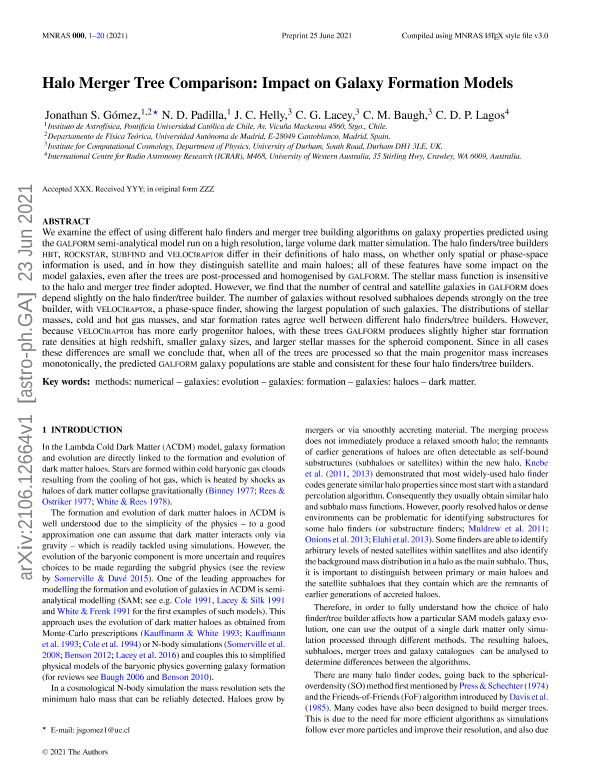Mostrar el registro sencillo del ítem
dc.contributor.author
Gómez, Jonathan S.
dc.contributor.author
Padilla, Nelson David

dc.contributor.author
Helly, J.C.
dc.contributor.author
Lacey, C.G.
dc.contributor.author
Baugh, C.M.
dc.contributor.author
Lagos, C.D.P.
dc.date.available
2023-07-10T14:39:49Z
dc.date.issued
2022-03
dc.identifier.citation
Gómez, Jonathan S.; Padilla, Nelson David; Helly, J.C.; Lacey, C.G.; Baugh, C.M.; et al.; Halo merger tree comparison: Impact on galaxy formation models; Oxford University Press; Monthly Notices of the Royal Astronomical Society; 510; 4; 3-2022; 5500-5519
dc.identifier.issn
0035-8711
dc.identifier.uri
http://hdl.handle.net/11336/202962
dc.description.abstract
We examine the effect of using different halo finders and merger tree building algorithms on galaxy properties predicted using the galform semi-analytical model run on a high resolution, large volume dark matter simulation. The halo finders/tree builders hbt, rockstar, subfind, and VELOCI raptor differ in their definitions of halo mass, on whether only spatial or phase-space information is used, and in how they distinguish satellite and main haloes; all of these features have some impact on the model galaxies, even after the trees are post-processed and homogenized by galform. The stellar mass function is insensitive to the halo and merger tree finder adopted. However, we find that the number of central and satellite galaxies in galform does depend slightly on the halo finder/tree builder. The number of galaxies without resolved subhaloes depends strongly on the tree builder, with VELOCIraptor, a phase-space finder, showing the largest population of such galaxies. The distributions of stellar masses, cold and hot gas masses, and star formation rates agree well between different halo finders/tree builders. However, because VELOCIraptor has more early progenitor haloes, with these trees galform produces slightly higher star formation rate densities at high redshift, smaller galaxy sizes, and larger stellar masses for the spheroid component. Since in all cases these differences are small we conclude that, when all of the trees are processed so that the main progenitor mass increases monotonically, the predicted galform galaxy populations are stable and consistent for these four halo finders/tree builders.
dc.format
application/pdf
dc.language.iso
eng
dc.publisher
Oxford University Press

dc.rights
info:eu-repo/semantics/openAccess
dc.rights.uri
https://creativecommons.org/licenses/by/2.5/ar/
dc.subject
DARK MATTER
dc.subject
GALAXIES: EVOLUTION
dc.subject
GALAXIES: FORMATION
dc.subject
GALAXIES: HALOES
dc.subject
METHODS: NUMERICAL
dc.subject.classification
Astronomía

dc.subject.classification
Ciencias Físicas

dc.subject.classification
CIENCIAS NATURALES Y EXACTAS

dc.title
Halo merger tree comparison: Impact on galaxy formation models
dc.type
info:eu-repo/semantics/article
dc.type
info:ar-repo/semantics/artículo
dc.type
info:eu-repo/semantics/publishedVersion
dc.date.updated
2023-07-06T11:31:29Z
dc.journal.volume
510
dc.journal.number
4
dc.journal.pagination
5500-5519
dc.journal.pais
Reino Unido

dc.journal.ciudad
Oxford
dc.description.fil
Fil: Gómez, Jonathan S.. Universidad Autónoma de Madrid; España. Pontificia Universidad Católica de Chile; Chile. Universidad Católica de Chile; Chile
dc.description.fil
Fil: Padilla, Nelson David. Universidad Católica de Chile; Chile. Pontificia Universidad Católica de Chile; Chile. Consejo Nacional de Investigaciones Científicas y Técnicas. Centro Científico Tecnológico Conicet - Córdoba. Instituto de Astronomía Teórica y Experimental. Universidad Nacional de Córdoba. Observatorio Astronómico de Córdoba. Instituto de Astronomía Teórica y Experimental; Argentina
dc.description.fil
Fil: Helly, J.C.. University of Durham; Reino Unido
dc.description.fil
Fil: Lacey, C.G.. University of Durham; Reino Unido
dc.description.fil
Fil: Baugh, C.M.. University of Durham; Reino Unido
dc.description.fil
Fil: Lagos, C.D.P.. University of Western Australia; Australia
dc.journal.title
Monthly Notices of the Royal Astronomical Society

dc.relation.alternativeid
info:eu-repo/semantics/altIdentifier/doi/http://dx.doi.org/10.1093/mnras/stab3661
dc.relation.alternativeid
info:eu-repo/semantics/altIdentifier/url/https://academic.oup.com/mnras/article-abstract/510/4/5500/6464107?redirectedFrom=fulltext
dc.relation.alternativeid
info:eu-repo/semantics/altIdentifier/arxiv/https://arxiv.org/abs/2106.12664
Archivos asociados
